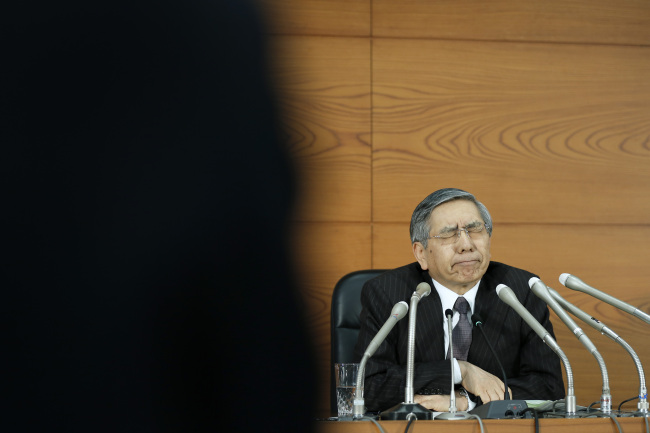 |
Bank of Japan Gov. Haruhiko Kuroda. (Bloomberg) |
Japan’s central bank cut its inflation forecast and kept its unprecedented monetary easing unchanged as tumbling oil prices handicap efforts to reflate the world’s third-biggest economy.
The Bank of Japan will increase the monetary base at an annual pace of 80 trillion yen ($674 billion), it said in a statement in Tokyo Wednesday, as forecast by all 33 economists surveyed by Bloomberg News. The BOJ lowered its inflation projection to 1 percent for the fiscal year starting in April.
The risk of consumer prices falling briefly this year as oil slumps highlights the challenge that Gov. Haruhiko Kuroda faces in reaching his 2 percent price goal after almost two years of record easing. He maintains that over the longer term the economy will benefit from the lower energy bill, with the central bank Wednesday raising its growth estimate to 2.1 percent for next fiscal year.
“Kuroda will be under pressure to increase stimulus,” Masamichi Adachi, an economist at JPMorgan Chase & Co., said before the decision. “It must be getting harder for him to communicate with market participants, with the economy expected to recover while inflation is slowing due to oil.”
Twenty-six of the 33 of economists in the Bloomberg survey expect the BOJ to ease more by the end of October. Fifteen of 31 who responded see the possibility that core consumer prices will decline year-on-year around midyear.
The yen advanced 0.9 percent against the dollar to 117.78 at 12:57 p.m. in Tokyo. The Topix index of shares retreated 1 percent.
The yield on Japan’s benchmark 10-year government bond was at 0.225 percent after dropping to a record low of 0.195 percent Tuesday.
Core inflation will accelerate to 2.2 percent in the year starting in April 2016, with gross domestic product expanding 1.6 percent, according to the BOJ’s forecasts, which are based on median projections of the nine-member policy board.
The BOJ’s economic outlook, which is more optimistic than forecasts from the International Monetary Fund, coincides with an expected weakening impact of a sales-tax increase last year and as falling oil prices reduce costs for some industries. Japan’s GDP is likely to grow by 0.6 percent this calendar year and by 0.8 percent in 2016, the IMF estimates.
“The BOJ will emphasize the positive aspects of falling oil prices,” Daiju Aoki, an economist at UBS Group AG in Tokyo, said before the decision. “But the path of consumer prices will clearly derail from its outlook. The BOJ will have to act as soon as July.”
Economy Minister Akira Amari said last week that achieving the BOJ’s 2 percent inflation target would be difficult in the coming fiscal year, given the government’s 1.4 percent projection.
Consumer prices excluding fresh food and the effects of a higher sales tax ― the BOJ’s main gauge ― rose 0.7 percent in November from a year earlier, down from last year’s 1.5 percent high in April.
Masazumi Wakatabe, a professor at Waseda University who is seen by Bank of America Corp. and UBS as a potential BOJ board candidate, said the central bank must consider additional stimulus.
Kuroda is counting on rising inflation expectations and a narrowing gap in supply and demand in the economy to help lift price gains.
The central bank said on Oct. 31 when it expanded the pace of its asset purchases that it was aiming to prevent the blow from oil delaying an end to a “deflationary mindset.” The October move demonstrated the BOJ’s determination to achieve its price target, Kuroda said on Dec. 19. (Bloomberg)







![[Today’s K-pop] Blackpink’s Jennie, Lisa invited to Coachella as solo acts](http://res.heraldm.com/phpwas/restmb_idxmake.php?idx=644&simg=/content/image/2024/11/21/20241121050099_0.jpg)
